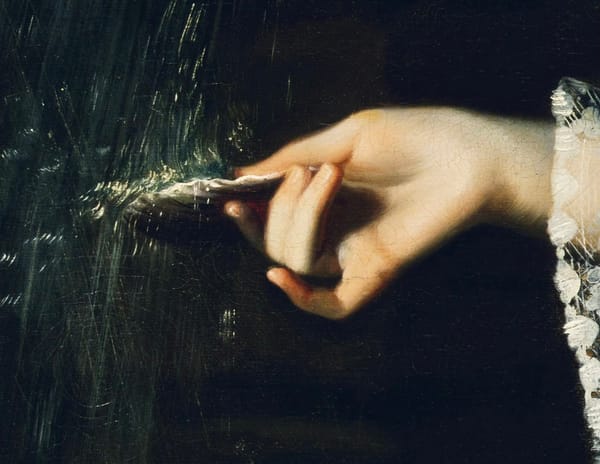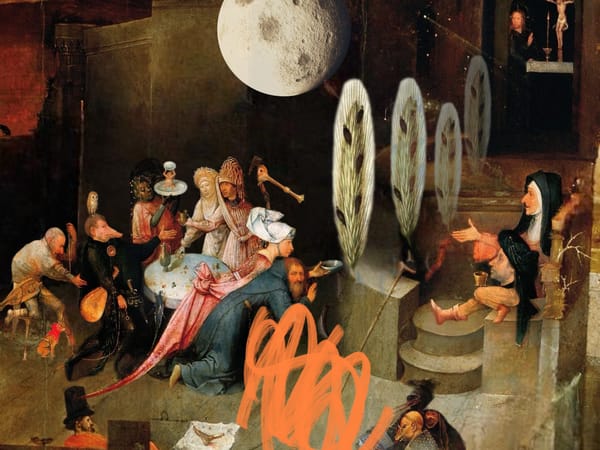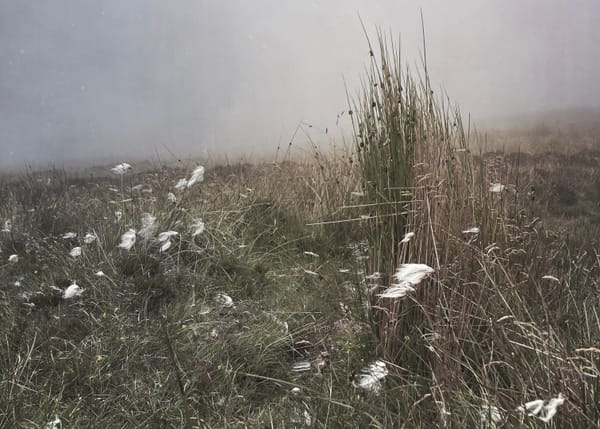THE DISABLED IMAGINATION & 90’S GHOSTS
bittersweet reveries of the Dior Cruise 2024 show
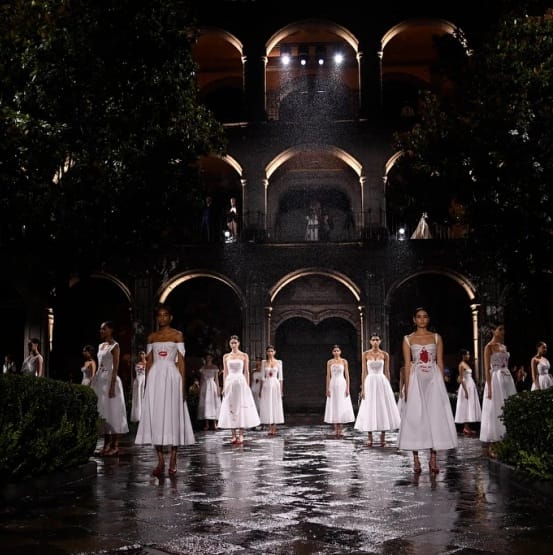
I pushed through the move to Orkney and the unpacking of almost all the boxes. Pushing through is something I’m not supposed to do, but do anyway. Now, of course, I’m flaring, which feels like being hit by a bus, like being a ghost. For days I’ve slept and sat in front of my laptop, obsessively watching Dior Cruise Couture shows. Stay with me here, I have meaning to mine in this obscene display of wealth.
“This is an homage to the genius of a queer, disabled, woman of colour who also happened to be a communist.”
In 2018 the house of Dior launched a dreamy-cringy cruise-wear line imprinted with images from the 1970s Motherpeace tarot deck by Karen Vogel and Vikki Nobel. This deck is round, which is cool because there are no inverted cards; everything is just dialled up or down. The images on the cards are drawn with childlike verve. The deck is a problematic icon of West Coast feminism. It was a deck I loved many years ago, before unanswered questions around it multiplied and I could no longer use it.
Missives from the Verge is a reader-supported publication. To receive new posts and support my work, consider becoming a free or paid subscriber.
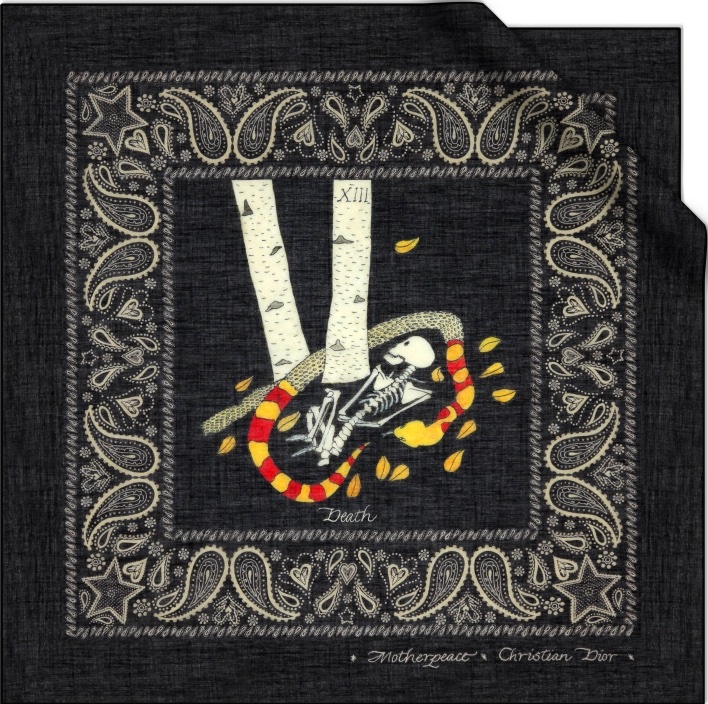
It’s disorienting to see these images on gowns that cost more than a book’s advance. (I now compare most sums to this little bucket of money meant to see a writer through many years of writing and beyond.) Italian designer Maria Grazie Chuiri, the first woman to head Dior, set the show in Calabasas at dusk, staged like a wild western outpost, a Coachella happening. Calabasas, a ‘rural, wild’ place thirty miles outside of Los Angeles, is now the richest town in the United States, home to the Kardashians and A list screenwriters. There is beauty in Chuiri’s high lonesome palette of terracotta and ochre.
Chuiri was inspired by Clarissa Pinkola Estes’ Women Who Run with the Wolves as a starting point for the collection. This was one of the feminisms that saved me when I was just learning about being a woman, scrambling for an opening into life like a trapped animal—not unlike the animals used for the fur vests in this runway collection. Shamefully, Dior is one of the remaining fashion houses that still use fur.
Certain threads of white feminism from 1970s-80s are also farmed, adopted by the wealthy and powerful. They’re bankrupted, their meanings distorted. Our dreams are sold over and over again to others who don’t even know what they might mean, but they’re still redolent with the perfume of our hopes, our uncanny survival. Someone is cashing in—perhaps the very women who initially thought they orchestrated a liberation.
As our bodies no longer fit in an ablest world, we must rely on other ways of world building, both personal and cultural.
I keep dreaming, and dreaming again, despite this truth, in spite of it. Spite drives me on these days—pushing through it. Just two days ago I managed a walk to the harbour where a massive cruise ship waited in the distance for its passengers to return from their wanderings. They were not wearing couture, but high tech gear, woolly hats and gloves, wrapped up against the Orcadian summer. A ferry was just coming in from one of the outer islands. I’ll need time to get used to this industrial seascape, not unlike where I lived in Long Beach in the United States. It is unlovely at first glance.
I perched on the stones bordering the wide, paved path, watching the black-headed gulls circle and dive in the shallows. Their distinctive summer plumage is startling white with a black, plague doctor mask. They are called swarfarro in the Orcadian dialect—black chicken—because their eggs are a delicacy, and were once sold by the hundreds of thousands in places like Leadenhall Market in London. Over-harvesting meant the bird was near extinction in the 19th century. You can still buy black-headed gull eggs on the internet at gourmet food sites, though the RSPB, the Royal Society for the Protection of Birds, has demanded this practice be banned. The bird is sometimes called rittock, which can also mean a spiteful woman.
As I sit and watch the ferry depart, a massive harbour seal peeks at me from the shallows. She gazes in mock surprise. A second pops up, adding to the mirth. Like two jesters, they bob and regard me—is this not enough for you, then, rittock, swarfarro, you gloomy, spiteful hen?
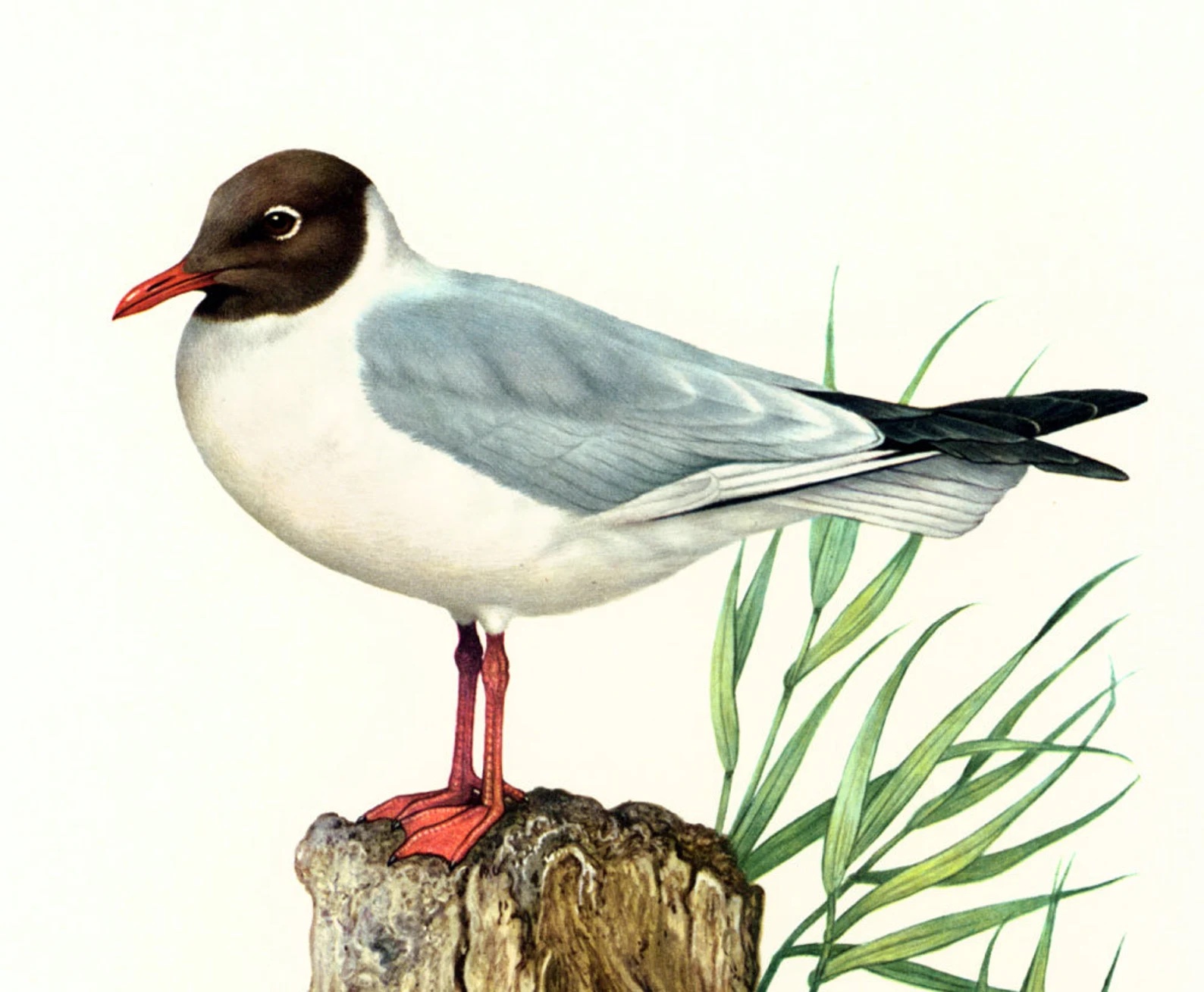
I contemplate the red of the black gull’s beak. How deep it is—a lipstick red. I would like a lippy in that colour. In my late teens I had a tube of waxy, matte lipstick like that—what I can now call ‘gull-beak red’. I wore it into the 90s, when I worked in the San Francisco State University library periodicals department. I dressed in vintage slips and moth-eaten 40s dresses bought for 3 dollars a pound at Clothes Contact in the Mission, hiding in the stacks and pouring over Vogue Italia and Harper’s Bazaar.
My love of couture is long standing if toxic. Lately I have become obsessed with Maria Grazie Chuiri’s work the way someone might love-hate a sports team. In her recent 2024 Cruise show for Dior she has sent an arrow straight for my heart. Stern POC models in black pigtails sway over the rain wet cobbles of the courtyard of Antiguo Colegio de San Ildefonso in Mexico City, the building where, as a girl, Frida Khalo met Diego Rivera as he painted its murals. The theatre of the runway show tells a story of una chicquita muy seria who became una leyenda—a very serious little girl who becomes a legend.
The show embodies a longing I had almost forgotten—estoy nostálgica por Aztlán—I’m homesick for Aztlán, the ancestral home of the Aztec people and a homeland of the Chicano people in the Southwestern United States and beyond. It’s alarming that many people in Scotland see Mexico only as a place of drug wars and abject poverty. They watch Breaking Bad, etc. and think they know the place. This runway show counters these stereotypes with an elegant vision of Mexico.
Is it Mexico I’m missing, or a dream of Aztlán? Or is it just some rarified vision of the SoCal I knew in the 90s, all shook out from riot grrl, Norteño and grunge? These places and times are encapsulated in this runway show. The couture collection is full of embroidered mesh dresses, embellished denim, chokers and Y rosary necklaces of that decade, with a butterfly motif that will spur a hundred thousand copies.
The models come out of the starkly lit building like figures from a Remedios Varo or Leonora Carrington painting. Their surreal presence is a past write large: here Frida’s tweed suits are given a mariachi intricacy, her dresses reinvented in Dior’s revolutionary ‘New Look’ silhouette from 1947—the wasp waist, soft shoulders and full skirt. Mexican textile techniques are employed by traditional artisans and the effect is breathtaking.
I suggest watching all nineteen minutes of the runway show, repeating as you do, “This is an homage to the genius of a queer, disabled, woman of colour who also happened to be a communist.” Let the words transform the privilege and money a runway show represents. Like the ever-present mariposa, let it change.
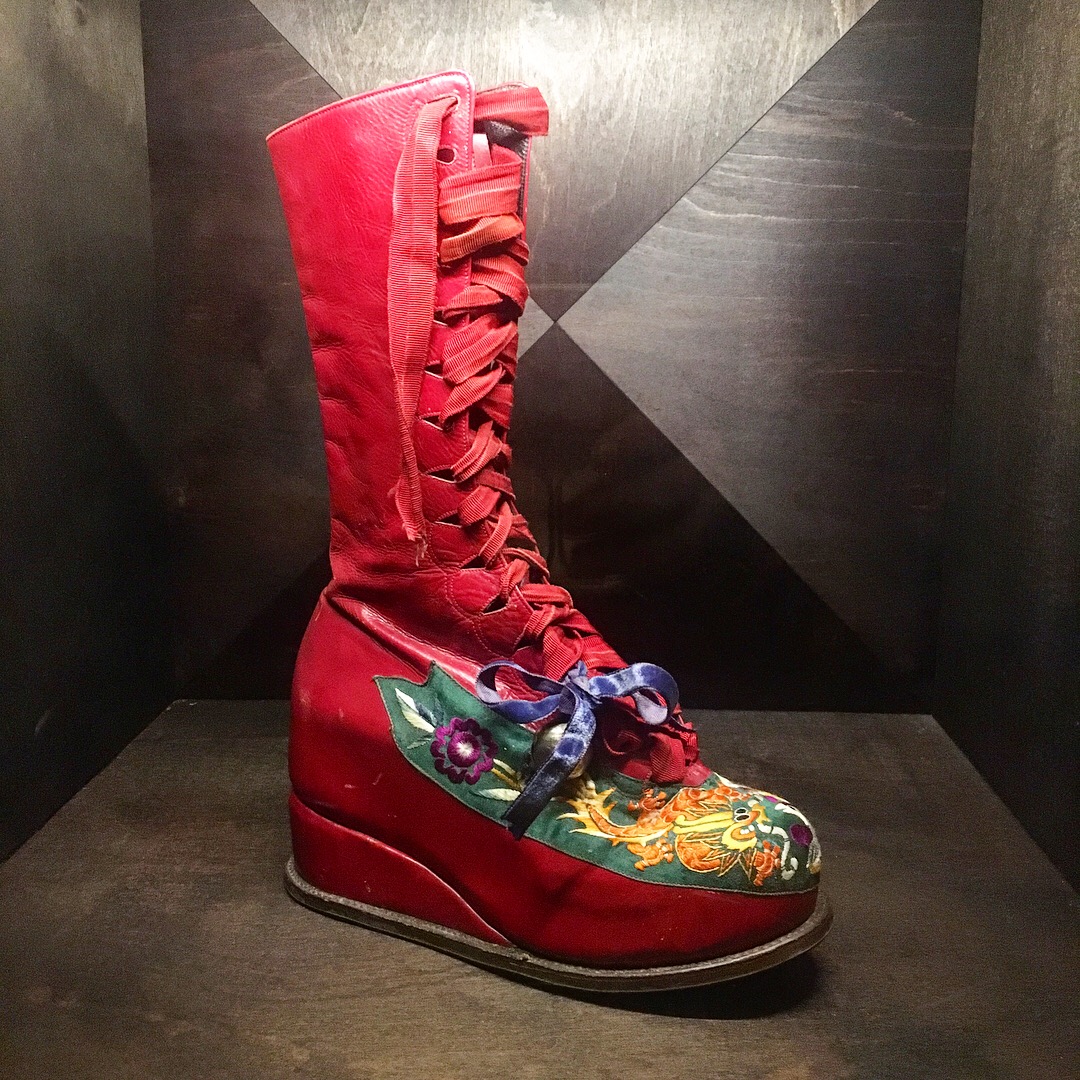
Here also is praise for the disabled imagination—or at least I am choosing to see it that way. Frida’s subversive reverie: Frida painting from her bed. Frida embellishing her cast as she lay prone. Frida’s red orthopaedic boots, complete with a bell tied with blue velvet ribbon. As our bodies no longer fit in an ablest world, we must rely on other ways of world building, both personal and cultural. This is a perpetual invention, grown from reverie, daydream, and profound napping as much as other forms of self care and advocacy. If every step is agony, at least it will ring out—because we have dreamed and made it so.
Frida’s boots have gone viral on the internet, some including pictures of her prosthetic leg inside them—the ultimate inspiration-porn. Since the publication of my book, I turn to Frida again and again. Her paintings were the images I used to heal from sexual trauma as a young woman. She threw me a rope then, and does so again now. I seek meaning in the confinement of my disability. I endure the affront of ablest othering—our pain fetishised. This is perhaps the most shocking thing I have experienced since my book has gone out into the world just four months ago—that shit is now directed towards me.
In the late 90s I walked everywhere. I lived in Southern California—Aztlán—and wrote about decaying movie palaces, dingy cocktail bars and other places long ago sacrificed to gentrification. I learned to write in Spanish and visited Mexico many times over. It was a brief, sanguine period in my life. Perhaps I only dreamed it, but damn if it isn’t glimmering there in the rain on the paving stones of that Dior show.
Missives from the Verge is a reader-supported publication. To receive new posts and support my work, consider becoming a free or paid subscriber.

